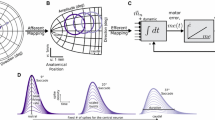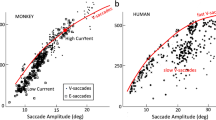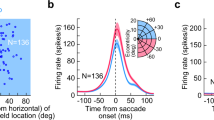Abstract
An earlier model for the collicular role in the generation of saccades (Van Gisbergen et al. 1987), based on ensemble coding and linear vector addition of movement contributions from independent movement cells, yields normometric saccades in all directions over a considerable range of amplitudes. The model, however, cannot account for two nonlinear phenomena which are known from collicular electrical stimulation experiments: 1) saccade amplitude has a roughly sigmoid dependence upon current strength and 2) two electrical stimuli applied simultaneously at different sites yield a response that resembles a weighted average of the individual responses. In the present paper we propose an intracollicular mechanism which, based on lateral spatial interactions in the deeper layers of the colliculus, results in nearby excitation and remote inhibition when current is applied. Both nonlinear phenomena can thus be explained. The possibility of excitatory and inhibitory collicular interactions is supported by recent evidence in the literature. The nonlinearity in the model, essential to explain the electrical stimulation findings, resides in the input-output characteristic of the deeper layer movement cells. The results, obtained by quantitative simulations with the model, are discussed together with possible alternative explanations.
Similar content being viewed by others
References
Alexander GE, Delong HR (1985) Microstimulation of the primate neostriatum. I. Physiological properties of striatal microexcitable zones. J Neurophysiol 53:1401–1416
Becker W, Jürgens R (1979) An analysis of the saccadic system by means of double step stimuli. Vision Res 19:967–983
Carpenter RHS (1977) Movements of the eyes. Pion, London
Douglas RM, Vetter M (1986) Widespread inhibition and target selection in the superior colliculus. Soc Neurosci (abstr) 12:458
Egelhaaf M (1985) On the neuronal basis of figure-ground discrimination by relative motion in the visual system of the fly. I. Behavioural constraints imposed on the neuronal network and the role of the optomotor system. Biol Cybern 52:123–140
Ferman L, Collewijn H, Van den Berg AV (1987) A direct test of Listing's law. II. Human ocular torsion measured under dynamic conditions. Vision Res 27:939–951
Findlay JM (1982) Global visual processing for saccadic eye movements. Vision Res 22:1033–1045
Goldberg ME, Bushnell MC, Bruce CJ (1986) The effect of attentive fixation on eye movements evoked by electrical stimulation of the frontal eye fields. Exp Brain Res 61:579–584
Infante C, Leiva J (1986) Simultaneous unitary neuronal activity in both superior colliculi and its relation to eye movements in the cat. Brain Res 381:390–392
McIlwain JT (1976) Large receptive fields and spatial transformations in the visual system. Int Rev Physiol 10:223–248
McIlwain JT (1982) Lateral spread of neural excitation during microstimulation in intermediate gray layer of cat's superior colliculus. J Neurophysiol 47:167–178
Ottes FP, Van Gisbergen JAM, Eggermont JJ (1984) Metrics of saccade responses to visual double stimuli: two different modes. Vision Res 24:1169–1179
Ottes FP, Van Gisbergen JAM, Eggermont JJ (1986) Visuomotor fields of the superior colliculus: a quantitative model. Vision Res 26:857–873
Reichardt W, Poggio T, Hausen K (1983) Figure-ground discrimination by relative movement in the visual system of the fly. Part II. Towards a neural circuitry. Biol Cybern 46 [Suppl]:1–30
Rizzolatti G, Camarda R, Grupp LA, Pisa M (1973) Inhibition of visual responses of single units in the cat superior colliculus by the introduction of a second visual stimulus. Brain Res 61:390–394
Rizzolatti G, Camarda P, Grupp LA, Pisa M (1974) Inhibitory effect of remote visual stimuli on visual response of cat superior colliculus: spatial and temporal factors. J Neurophysiol 37:1262–1275
Robinson DA (1972) Eye movements evoked by collicular stimulation in the alert monkey. Vision Res 12:1795–1807
Robinson DA, Fuchs AF (1969) Eye movements evoked by stimulation of frontal eye fields. J Neurophysiol 32:637–648
Schiller PH (1984) The superior colliculus and visual function. In: Brookhart JM, Mountcastle VB (eds) Handbook of physiology, vol III. American Physiological Society, Md, USA
Schiller PH, Sandell JH (1983) Interactions between visually and electrically elicited saccades before and after superior colliculus ablations in the rhesus monkey. Exp Brain Res 49:381–392
Schiller PH, Stryker M (1972) Single-unit recording and stimulation in superior colliculus of the alert rhesus monkey. J Neurophysiol 35:915–924
Schiller PH, Sandell JH, Maunsell JHR (1987) The effect of frontal eye field and superior colliculus lesions on saccadic latencies in the rhesus monkey. J Neurophysiol 57:1033–1049
Sparks DL (1986) Translation of sensory signals into commands for control of saccadic eye movements: role of primate superior colliculus. Physiol Rev 66:118–171
Sparks DL, Mays LE (1980) Movement fields of saccade-related burst neurons in the monkey superior colliculus. Brain Res 190:39–50
Sparks DL, Mays LE (1983) Spatial localization of saccade targets. I. Compensation for stimulation-induced perturbations in eye position. J. Neurophysiol 49:45–63
Sparks DL, Holland R, Guthrie BL (1976) Size and distribution of movement fields in the monkey superior colliculus. Brain Res 113:21–34
Stoney SD Jr, Thompson WD, Asanuma H (1968) Excitation of pyramidal tract cells by intracortical microstimulation: effective extent of stimulating current. J Neurophysiol 31:659–669
Van Gisbergen JAM, Van Opstal AJ, Tax AAM (1987) Collicular ensemble coding of saccades based on vector summation. Neuroscience 21:541–555
Van Opstal AJ, Van Gisbergen JAM (1987) A nonlinear model of collicular spatial interactions possibly underlying saccadic averaging responses to electrical double stimulation. Neuroscience 22 [Suppl]:847
Van Opstal AJ, Van Gisbergen JAM (1989) A model for collicular efferent mechanisms underlying the generation of saccades. Brain Behav Evol (in press)
Wurtz RH, Goldberg ME (1972) Activity of superior colliculus in behaving monkey. III. Cells discharging before eye movements. J Neurophysiol 35:575–586
Wurtz RH, Richmond BJ, Judge SJ (1980) Vision during saccadic eye movements. III. Visual interactions in monkey superior colliculus. J Neurophysiol 43:1168–1181
Author information
Authors and Affiliations
Rights and permissions
About this article
Cite this article
Van Opstal, A.J., Van Gisbergen, J.A.M. A nonlinear model for collicular spatial interactions underlying the metrical properties of electrically elicited saccades. Biol. Cybern. 60, 171–183 (1989). https://doi.org/10.1007/BF00207285
Received:
Issue Date:
DOI: https://doi.org/10.1007/BF00207285




